Business Environment Report: Unit 1, Business and Environment
VerifiedAdded on 2021/02/19
|13
|4003
|279
Report
AI Summary
This report provides a comprehensive analysis of the business environment, organizational structures, and functions, with a focus on Marks & Spencer. It begins with an introduction to the business environment, defining internal and external factors. The report then delves into different types and purposes of organizations (profit, non-profit, and public sector), as well as their size and scope (micro, small, medium, and large enterprises). It explores the relationship between organizational functions, objectives, and structure, including hierarchical, matrix, and flat structures. A PESTLE analysis is used to examine the impact of macro-environmental factors on business operations. The report concludes with an internal and external analysis of Marks & Spencer, analyzing how strengths and weaknesses interrelate with external macro factors. References are included to support the analysis.
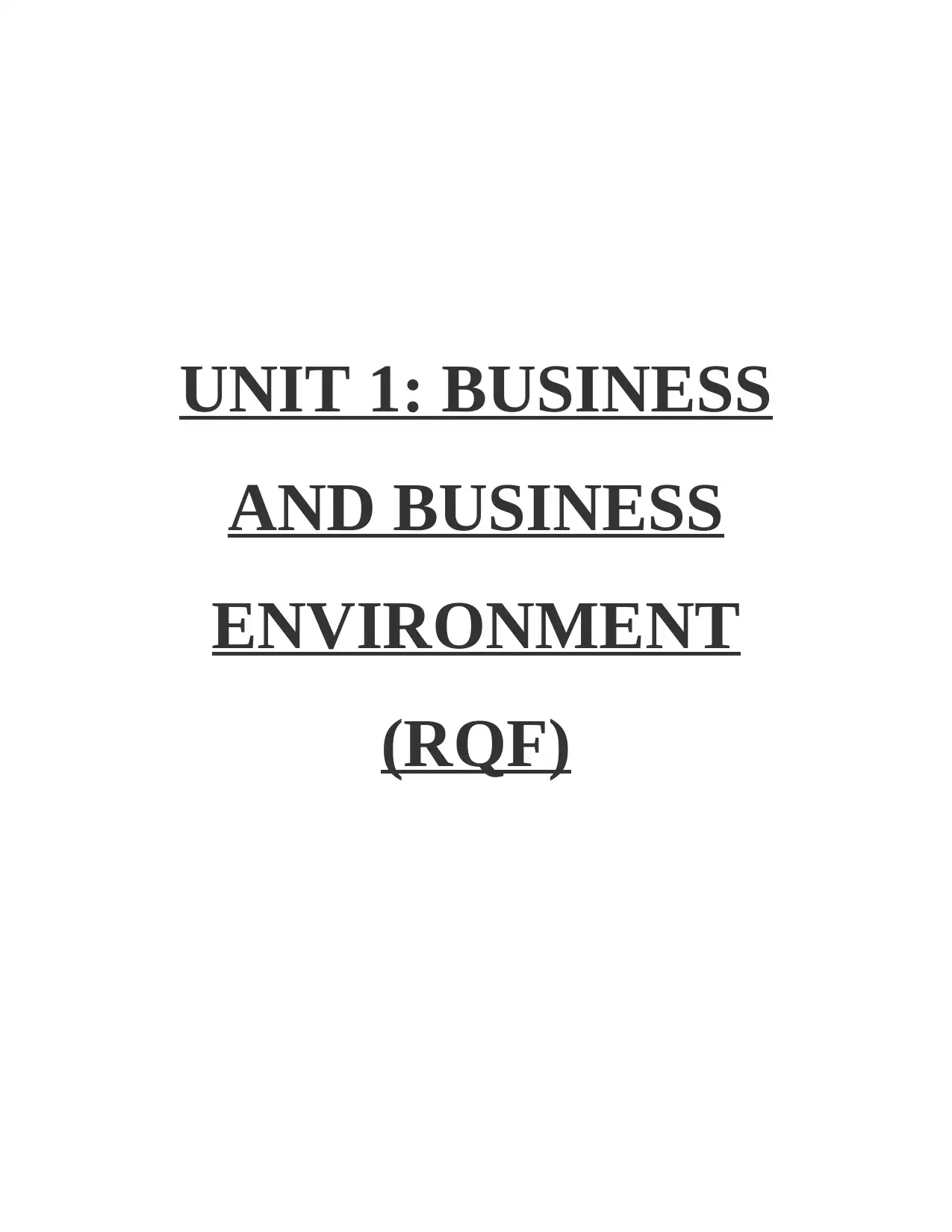
UNIT 1: BUSINESS
AND BUSINESS
ENVIRONMENT
(RQF)
AND BUSINESS
ENVIRONMENT
(RQF)
Paraphrase This Document
Need a fresh take? Get an instant paraphrase of this document with our AI Paraphraser
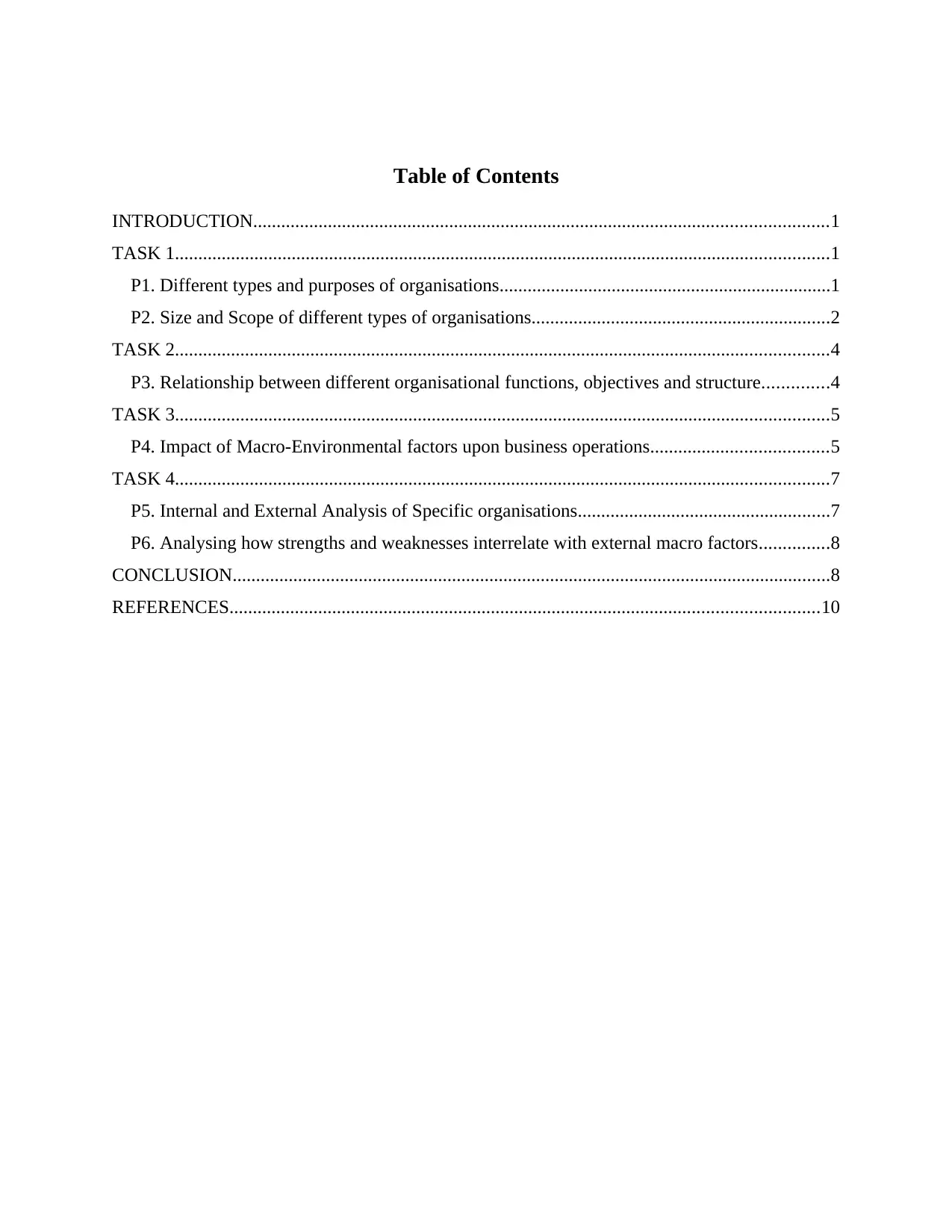
Table of Contents
INTRODUCTION...........................................................................................................................1
TASK 1............................................................................................................................................1
P1. Different types and purposes of organisations.......................................................................1
P2. Size and Scope of different types of organisations................................................................2
TASK 2............................................................................................................................................4
P3. Relationship between different organisational functions, objectives and structure..............4
TASK 3............................................................................................................................................5
P4. Impact of Macro-Environmental factors upon business operations......................................5
TASK 4............................................................................................................................................7
P5. Internal and External Analysis of Specific organisations......................................................7
P6. Analysing how strengths and weaknesses interrelate with external macro factors...............8
CONCLUSION................................................................................................................................8
REFERENCES..............................................................................................................................10
INTRODUCTION...........................................................................................................................1
TASK 1............................................................................................................................................1
P1. Different types and purposes of organisations.......................................................................1
P2. Size and Scope of different types of organisations................................................................2
TASK 2............................................................................................................................................4
P3. Relationship between different organisational functions, objectives and structure..............4
TASK 3............................................................................................................................................5
P4. Impact of Macro-Environmental factors upon business operations......................................5
TASK 4............................................................................................................................................7
P5. Internal and External Analysis of Specific organisations......................................................7
P6. Analysing how strengths and weaknesses interrelate with external macro factors...............8
CONCLUSION................................................................................................................................8
REFERENCES..............................................................................................................................10
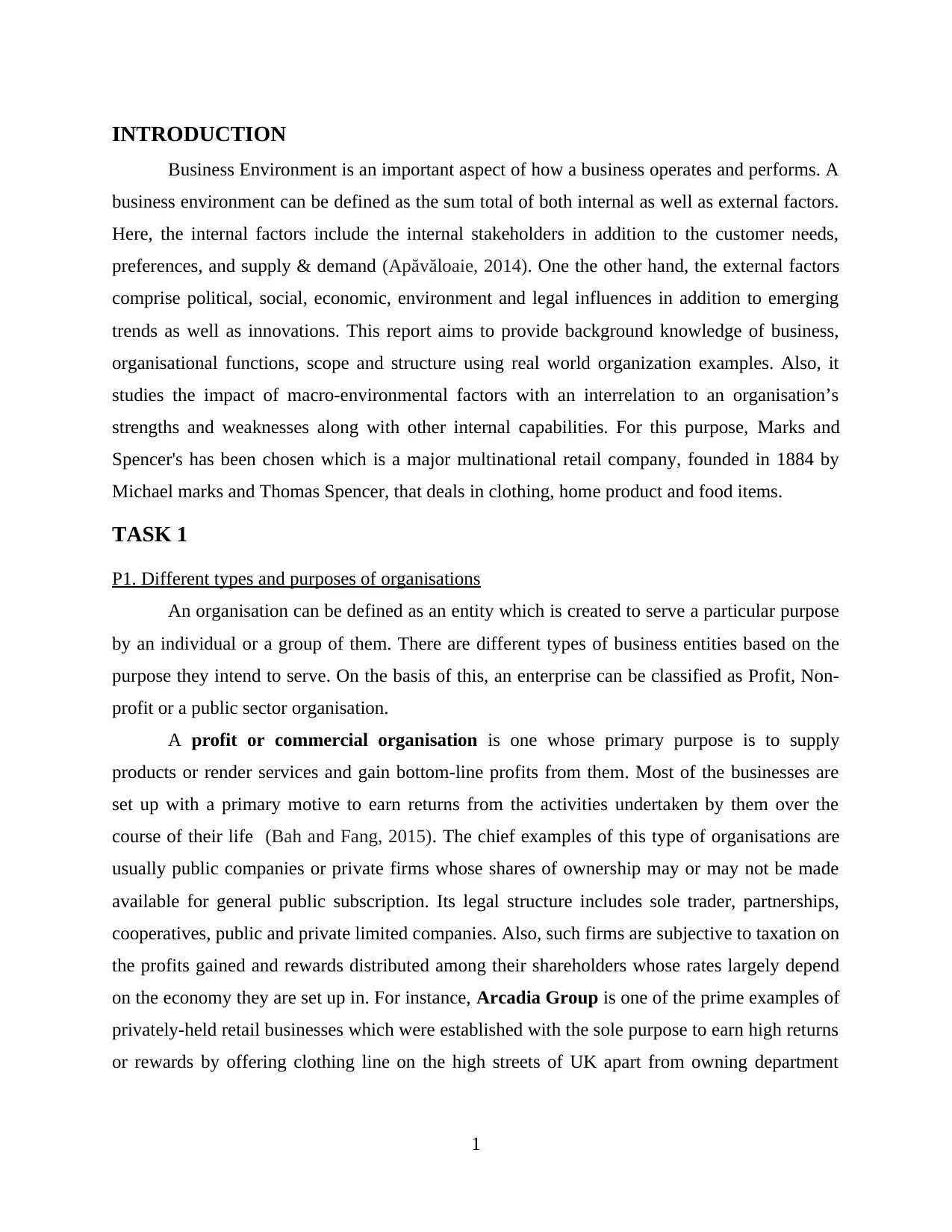
INTRODUCTION
Business Environment is an important aspect of how a business operates and performs. A
business environment can be defined as the sum total of both internal as well as external factors.
Here, the internal factors include the internal stakeholders in addition to the customer needs,
preferences, and supply & demand (Apăvăloaie, 2014). One the other hand, the external factors
comprise political, social, economic, environment and legal influences in addition to emerging
trends as well as innovations. This report aims to provide background knowledge of business,
organisational functions, scope and structure using real world organization examples. Also, it
studies the impact of macro-environmental factors with an interrelation to an organisation’s
strengths and weaknesses along with other internal capabilities. For this purpose, Marks and
Spencer's has been chosen which is a major multinational retail company, founded in 1884 by
Michael marks and Thomas Spencer, that deals in clothing, home product and food items.
TASK 1
P1. Different types and purposes of organisations
An organisation can be defined as an entity which is created to serve a particular purpose
by an individual or a group of them. There are different types of business entities based on the
purpose they intend to serve. On the basis of this, an enterprise can be classified as Profit, Non-
profit or a public sector organisation.
A profit or commercial organisation is one whose primary purpose is to supply
products or render services and gain bottom-line profits from them. Most of the businesses are
set up with a primary motive to earn returns from the activities undertaken by them over the
course of their life (Bah and Fang, 2015). The chief examples of this type of organisations are
usually public companies or private firms whose shares of ownership may or may not be made
available for general public subscription. Its legal structure includes sole trader, partnerships,
cooperatives, public and private limited companies. Also, such firms are subjective to taxation on
the profits gained and rewards distributed among their shareholders whose rates largely depend
on the economy they are set up in. For instance, Arcadia Group is one of the prime examples of
privately-held retail businesses which were established with the sole purpose to earn high returns
or rewards by offering clothing line on the high streets of UK apart from owning department
1
Business Environment is an important aspect of how a business operates and performs. A
business environment can be defined as the sum total of both internal as well as external factors.
Here, the internal factors include the internal stakeholders in addition to the customer needs,
preferences, and supply & demand (Apăvăloaie, 2014). One the other hand, the external factors
comprise political, social, economic, environment and legal influences in addition to emerging
trends as well as innovations. This report aims to provide background knowledge of business,
organisational functions, scope and structure using real world organization examples. Also, it
studies the impact of macro-environmental factors with an interrelation to an organisation’s
strengths and weaknesses along with other internal capabilities. For this purpose, Marks and
Spencer's has been chosen which is a major multinational retail company, founded in 1884 by
Michael marks and Thomas Spencer, that deals in clothing, home product and food items.
TASK 1
P1. Different types and purposes of organisations
An organisation can be defined as an entity which is created to serve a particular purpose
by an individual or a group of them. There are different types of business entities based on the
purpose they intend to serve. On the basis of this, an enterprise can be classified as Profit, Non-
profit or a public sector organisation.
A profit or commercial organisation is one whose primary purpose is to supply
products or render services and gain bottom-line profits from them. Most of the businesses are
set up with a primary motive to earn returns from the activities undertaken by them over the
course of their life (Bah and Fang, 2015). The chief examples of this type of organisations are
usually public companies or private firms whose shares of ownership may or may not be made
available for general public subscription. Its legal structure includes sole trader, partnerships,
cooperatives, public and private limited companies. Also, such firms are subjective to taxation on
the profits gained and rewards distributed among their shareholders whose rates largely depend
on the economy they are set up in. For instance, Arcadia Group is one of the prime examples of
privately-held retail businesses which were established with the sole purpose to earn high returns
or rewards by offering clothing line on the high streets of UK apart from owning department
1
⊘ This is a preview!⊘
Do you want full access?
Subscribe today to unlock all pages.

Trusted by 1+ million students worldwide
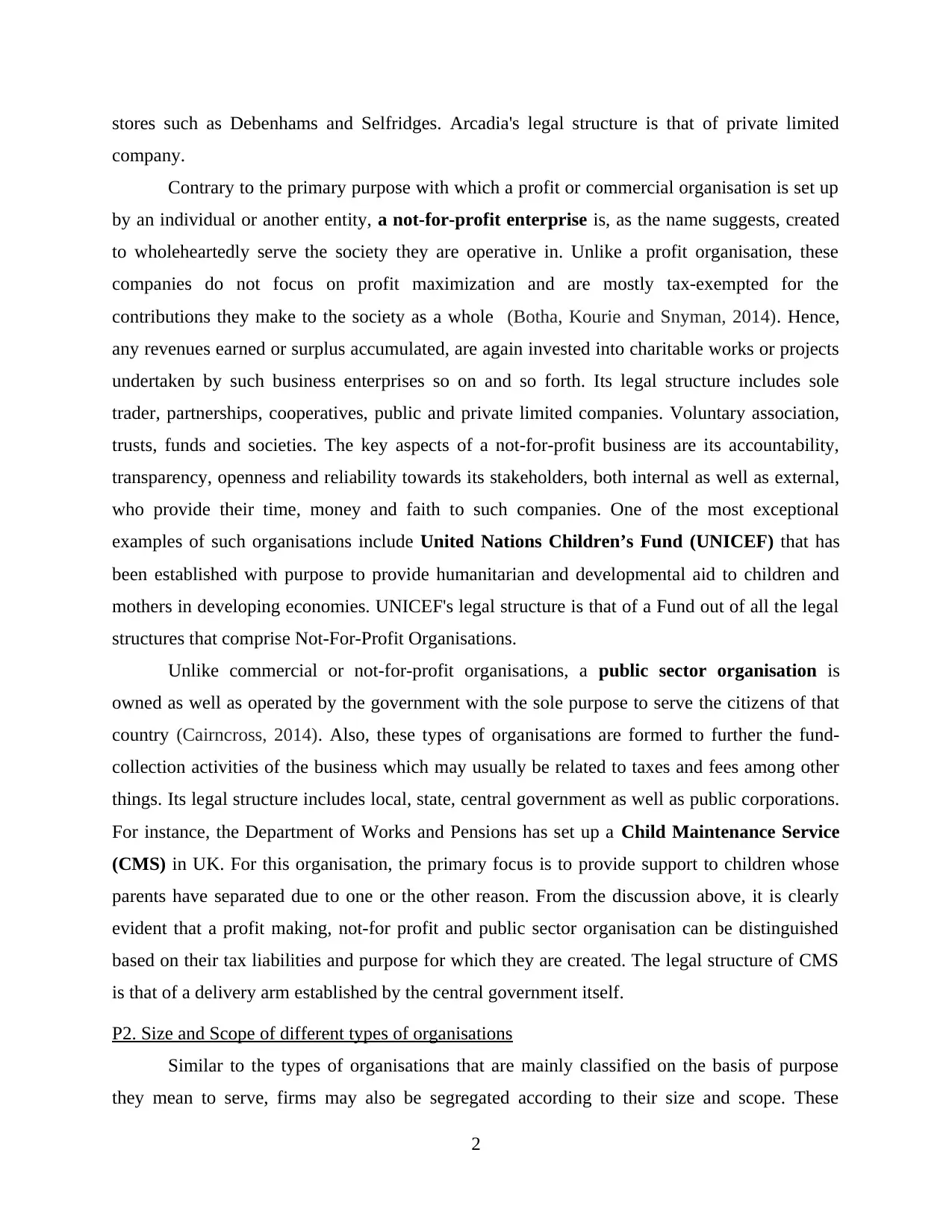
stores such as Debenhams and Selfridges. Arcadia's legal structure is that of private limited
company.
Contrary to the primary purpose with which a profit or commercial organisation is set up
by an individual or another entity, a not-for-profit enterprise is, as the name suggests, created
to wholeheartedly serve the society they are operative in. Unlike a profit organisation, these
companies do not focus on profit maximization and are mostly tax-exempted for the
contributions they make to the society as a whole (Botha, Kourie and Snyman, 2014). Hence,
any revenues earned or surplus accumulated, are again invested into charitable works or projects
undertaken by such business enterprises so on and so forth. Its legal structure includes sole
trader, partnerships, cooperatives, public and private limited companies. Voluntary association,
trusts, funds and societies. The key aspects of a not-for-profit business are its accountability,
transparency, openness and reliability towards its stakeholders, both internal as well as external,
who provide their time, money and faith to such companies. One of the most exceptional
examples of such organisations include United Nations Children’s Fund (UNICEF) that has
been established with purpose to provide humanitarian and developmental aid to children and
mothers in developing economies. UNICEF's legal structure is that of a Fund out of all the legal
structures that comprise Not-For-Profit Organisations.
Unlike commercial or not-for-profit organisations, a public sector organisation is
owned as well as operated by the government with the sole purpose to serve the citizens of that
country (Cairncross, 2014). Also, these types of organisations are formed to further the fund-
collection activities of the business which may usually be related to taxes and fees among other
things. Its legal structure includes local, state, central government as well as public corporations.
For instance, the Department of Works and Pensions has set up a Child Maintenance Service
(CMS) in UK. For this organisation, the primary focus is to provide support to children whose
parents have separated due to one or the other reason. From the discussion above, it is clearly
evident that a profit making, not-for profit and public sector organisation can be distinguished
based on their tax liabilities and purpose for which they are created. The legal structure of CMS
is that of a delivery arm established by the central government itself.
P2. Size and Scope of different types of organisations
Similar to the types of organisations that are mainly classified on the basis of purpose
they mean to serve, firms may also be segregated according to their size and scope. These
2
company.
Contrary to the primary purpose with which a profit or commercial organisation is set up
by an individual or another entity, a not-for-profit enterprise is, as the name suggests, created
to wholeheartedly serve the society they are operative in. Unlike a profit organisation, these
companies do not focus on profit maximization and are mostly tax-exempted for the
contributions they make to the society as a whole (Botha, Kourie and Snyman, 2014). Hence,
any revenues earned or surplus accumulated, are again invested into charitable works or projects
undertaken by such business enterprises so on and so forth. Its legal structure includes sole
trader, partnerships, cooperatives, public and private limited companies. Voluntary association,
trusts, funds and societies. The key aspects of a not-for-profit business are its accountability,
transparency, openness and reliability towards its stakeholders, both internal as well as external,
who provide their time, money and faith to such companies. One of the most exceptional
examples of such organisations include United Nations Children’s Fund (UNICEF) that has
been established with purpose to provide humanitarian and developmental aid to children and
mothers in developing economies. UNICEF's legal structure is that of a Fund out of all the legal
structures that comprise Not-For-Profit Organisations.
Unlike commercial or not-for-profit organisations, a public sector organisation is
owned as well as operated by the government with the sole purpose to serve the citizens of that
country (Cairncross, 2014). Also, these types of organisations are formed to further the fund-
collection activities of the business which may usually be related to taxes and fees among other
things. Its legal structure includes local, state, central government as well as public corporations.
For instance, the Department of Works and Pensions has set up a Child Maintenance Service
(CMS) in UK. For this organisation, the primary focus is to provide support to children whose
parents have separated due to one or the other reason. From the discussion above, it is clearly
evident that a profit making, not-for profit and public sector organisation can be distinguished
based on their tax liabilities and purpose for which they are created. The legal structure of CMS
is that of a delivery arm established by the central government itself.
P2. Size and Scope of different types of organisations
Similar to the types of organisations that are mainly classified on the basis of purpose
they mean to serve, firms may also be segregated according to their size and scope. These
2
Paraphrase This Document
Need a fresh take? Get an instant paraphrase of this document with our AI Paraphraser
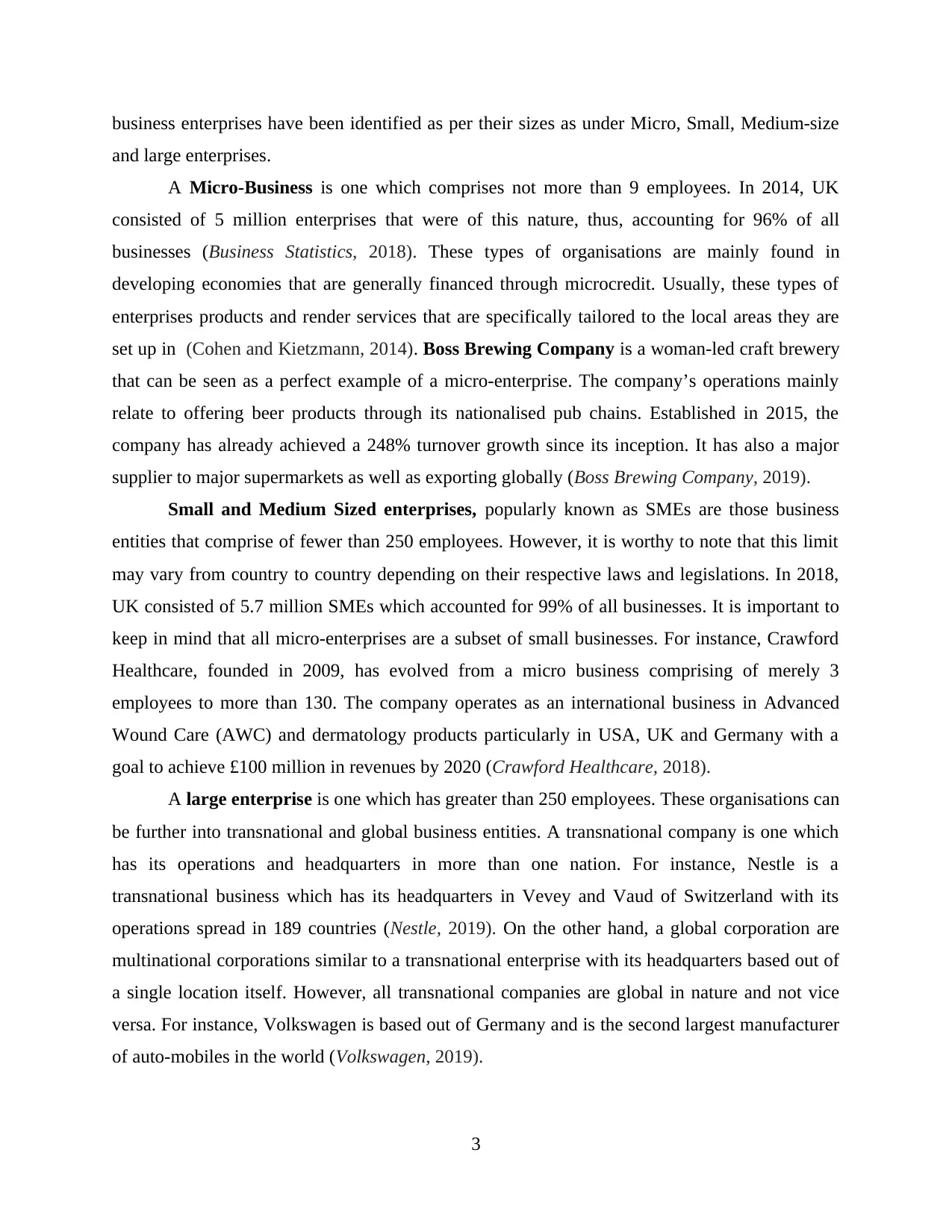
business enterprises have been identified as per their sizes as under Micro, Small, Medium-size
and large enterprises.
A Micro-Business is one which comprises not more than 9 employees. In 2014, UK
consisted of 5 million enterprises that were of this nature, thus, accounting for 96% of all
businesses (Business Statistics, 2018). These types of organisations are mainly found in
developing economies that are generally financed through microcredit. Usually, these types of
enterprises products and render services that are specifically tailored to the local areas they are
set up in (Cohen and Kietzmann, 2014). Boss Brewing Company is a woman-led craft brewery
that can be seen as a perfect example of a micro-enterprise. The company’s operations mainly
relate to offering beer products through its nationalised pub chains. Established in 2015, the
company has already achieved a 248% turnover growth since its inception. It has also a major
supplier to major supermarkets as well as exporting globally (Boss Brewing Company, 2019).
Small and Medium Sized enterprises, popularly known as SMEs are those business
entities that comprise of fewer than 250 employees. However, it is worthy to note that this limit
may vary from country to country depending on their respective laws and legislations. In 2018,
UK consisted of 5.7 million SMEs which accounted for 99% of all businesses. It is important to
keep in mind that all micro-enterprises are a subset of small businesses. For instance, Crawford
Healthcare, founded in 2009, has evolved from a micro business comprising of merely 3
employees to more than 130. The company operates as an international business in Advanced
Wound Care (AWC) and dermatology products particularly in USA, UK and Germany with a
goal to achieve £100 million in revenues by 2020 (Crawford Healthcare, 2018).
A large enterprise is one which has greater than 250 employees. These organisations can
be further into transnational and global business entities. A transnational company is one which
has its operations and headquarters in more than one nation. For instance, Nestle is a
transnational business which has its headquarters in Vevey and Vaud of Switzerland with its
operations spread in 189 countries (Nestle, 2019). On the other hand, a global corporation are
multinational corporations similar to a transnational enterprise with its headquarters based out of
a single location itself. However, all transnational companies are global in nature and not vice
versa. For instance, Volkswagen is based out of Germany and is the second largest manufacturer
of auto-mobiles in the world (Volkswagen, 2019).
3
and large enterprises.
A Micro-Business is one which comprises not more than 9 employees. In 2014, UK
consisted of 5 million enterprises that were of this nature, thus, accounting for 96% of all
businesses (Business Statistics, 2018). These types of organisations are mainly found in
developing economies that are generally financed through microcredit. Usually, these types of
enterprises products and render services that are specifically tailored to the local areas they are
set up in (Cohen and Kietzmann, 2014). Boss Brewing Company is a woman-led craft brewery
that can be seen as a perfect example of a micro-enterprise. The company’s operations mainly
relate to offering beer products through its nationalised pub chains. Established in 2015, the
company has already achieved a 248% turnover growth since its inception. It has also a major
supplier to major supermarkets as well as exporting globally (Boss Brewing Company, 2019).
Small and Medium Sized enterprises, popularly known as SMEs are those business
entities that comprise of fewer than 250 employees. However, it is worthy to note that this limit
may vary from country to country depending on their respective laws and legislations. In 2018,
UK consisted of 5.7 million SMEs which accounted for 99% of all businesses. It is important to
keep in mind that all micro-enterprises are a subset of small businesses. For instance, Crawford
Healthcare, founded in 2009, has evolved from a micro business comprising of merely 3
employees to more than 130. The company operates as an international business in Advanced
Wound Care (AWC) and dermatology products particularly in USA, UK and Germany with a
goal to achieve £100 million in revenues by 2020 (Crawford Healthcare, 2018).
A large enterprise is one which has greater than 250 employees. These organisations can
be further into transnational and global business entities. A transnational company is one which
has its operations and headquarters in more than one nation. For instance, Nestle is a
transnational business which has its headquarters in Vevey and Vaud of Switzerland with its
operations spread in 189 countries (Nestle, 2019). On the other hand, a global corporation are
multinational corporations similar to a transnational enterprise with its headquarters based out of
a single location itself. However, all transnational companies are global in nature and not vice
versa. For instance, Volkswagen is based out of Germany and is the second largest manufacturer
of auto-mobiles in the world (Volkswagen, 2019).
3
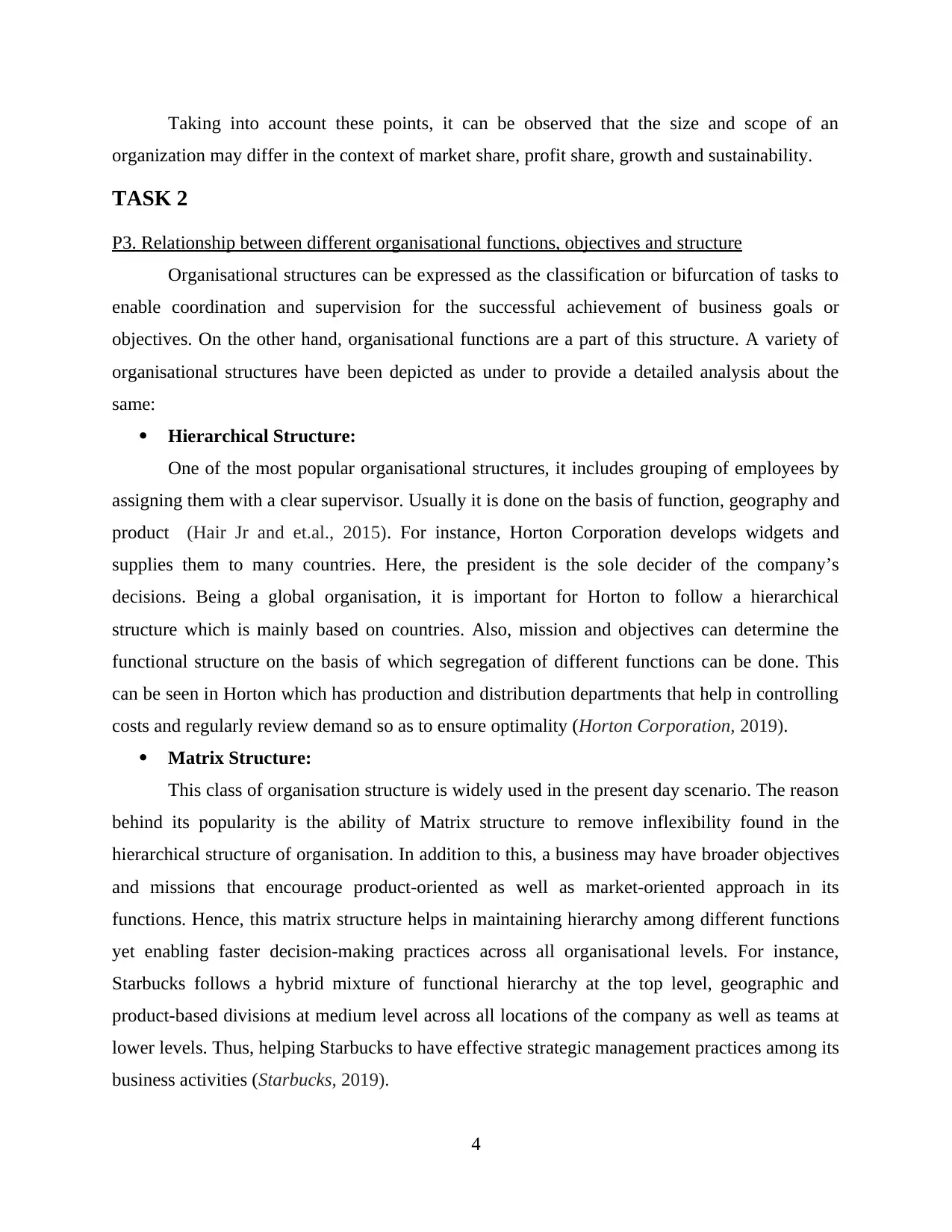
Taking into account these points, it can be observed that the size and scope of an
organization may differ in the context of market share, profit share, growth and sustainability.
TASK 2
P3. Relationship between different organisational functions, objectives and structure
Organisational structures can be expressed as the classification or bifurcation of tasks to
enable coordination and supervision for the successful achievement of business goals or
objectives. On the other hand, organisational functions are a part of this structure. A variety of
organisational structures have been depicted as under to provide a detailed analysis about the
same:
Hierarchical Structure:
One of the most popular organisational structures, it includes grouping of employees by
assigning them with a clear supervisor. Usually it is done on the basis of function, geography and
product (Hair Jr and et.al., 2015). For instance, Horton Corporation develops widgets and
supplies them to many countries. Here, the president is the sole decider of the company’s
decisions. Being a global organisation, it is important for Horton to follow a hierarchical
structure which is mainly based on countries. Also, mission and objectives can determine the
functional structure on the basis of which segregation of different functions can be done. This
can be seen in Horton which has production and distribution departments that help in controlling
costs and regularly review demand so as to ensure optimality (Horton Corporation, 2019).
Matrix Structure:
This class of organisation structure is widely used in the present day scenario. The reason
behind its popularity is the ability of Matrix structure to remove inflexibility found in the
hierarchical structure of organisation. In addition to this, a business may have broader objectives
and missions that encourage product-oriented as well as market-oriented approach in its
functions. Hence, this matrix structure helps in maintaining hierarchy among different functions
yet enabling faster decision-making practices across all organisational levels. For instance,
Starbucks follows a hybrid mixture of functional hierarchy at the top level, geographic and
product-based divisions at medium level across all locations of the company as well as teams at
lower levels. Thus, helping Starbucks to have effective strategic management practices among its
business activities (Starbucks, 2019).
4
organization may differ in the context of market share, profit share, growth and sustainability.
TASK 2
P3. Relationship between different organisational functions, objectives and structure
Organisational structures can be expressed as the classification or bifurcation of tasks to
enable coordination and supervision for the successful achievement of business goals or
objectives. On the other hand, organisational functions are a part of this structure. A variety of
organisational structures have been depicted as under to provide a detailed analysis about the
same:
Hierarchical Structure:
One of the most popular organisational structures, it includes grouping of employees by
assigning them with a clear supervisor. Usually it is done on the basis of function, geography and
product (Hair Jr and et.al., 2015). For instance, Horton Corporation develops widgets and
supplies them to many countries. Here, the president is the sole decider of the company’s
decisions. Being a global organisation, it is important for Horton to follow a hierarchical
structure which is mainly based on countries. Also, mission and objectives can determine the
functional structure on the basis of which segregation of different functions can be done. This
can be seen in Horton which has production and distribution departments that help in controlling
costs and regularly review demand so as to ensure optimality (Horton Corporation, 2019).
Matrix Structure:
This class of organisation structure is widely used in the present day scenario. The reason
behind its popularity is the ability of Matrix structure to remove inflexibility found in the
hierarchical structure of organisation. In addition to this, a business may have broader objectives
and missions that encourage product-oriented as well as market-oriented approach in its
functions. Hence, this matrix structure helps in maintaining hierarchy among different functions
yet enabling faster decision-making practices across all organisational levels. For instance,
Starbucks follows a hybrid mixture of functional hierarchy at the top level, geographic and
product-based divisions at medium level across all locations of the company as well as teams at
lower levels. Thus, helping Starbucks to have effective strategic management practices among its
business activities (Starbucks, 2019).
4
⊘ This is a preview!⊘
Do you want full access?
Subscribe today to unlock all pages.

Trusted by 1+ million students worldwide
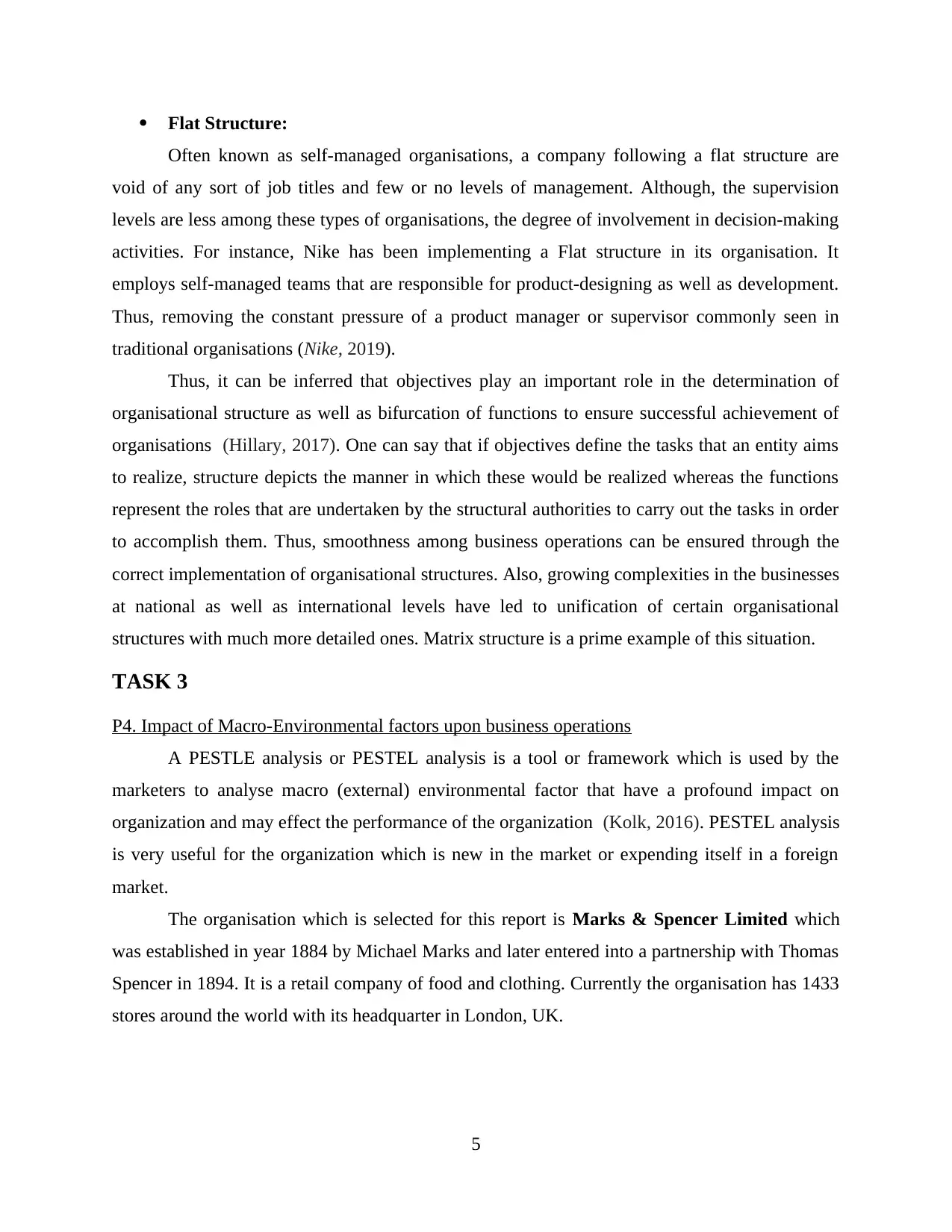
Flat Structure:
Often known as self-managed organisations, a company following a flat structure are
void of any sort of job titles and few or no levels of management. Although, the supervision
levels are less among these types of organisations, the degree of involvement in decision-making
activities. For instance, Nike has been implementing a Flat structure in its organisation. It
employs self-managed teams that are responsible for product-designing as well as development.
Thus, removing the constant pressure of a product manager or supervisor commonly seen in
traditional organisations (Nike, 2019).
Thus, it can be inferred that objectives play an important role in the determination of
organisational structure as well as bifurcation of functions to ensure successful achievement of
organisations (Hillary, 2017). One can say that if objectives define the tasks that an entity aims
to realize, structure depicts the manner in which these would be realized whereas the functions
represent the roles that are undertaken by the structural authorities to carry out the tasks in order
to accomplish them. Thus, smoothness among business operations can be ensured through the
correct implementation of organisational structures. Also, growing complexities in the businesses
at national as well as international levels have led to unification of certain organisational
structures with much more detailed ones. Matrix structure is a prime example of this situation.
TASK 3
P4. Impact of Macro-Environmental factors upon business operations
A PESTLE analysis or PESTEL analysis is a tool or framework which is used by the
marketers to analyse macro (external) environmental factor that have a profound impact on
organization and may effect the performance of the organization (Kolk, 2016). PESTEL analysis
is very useful for the organization which is new in the market or expending itself in a foreign
market.
The organisation which is selected for this report is Marks & Spencer Limited which
was established in year 1884 by Michael Marks and later entered into a partnership with Thomas
Spencer in 1894. It is a retail company of food and clothing. Currently the organisation has 1433
stores around the world with its headquarter in London, UK.
5
Often known as self-managed organisations, a company following a flat structure are
void of any sort of job titles and few or no levels of management. Although, the supervision
levels are less among these types of organisations, the degree of involvement in decision-making
activities. For instance, Nike has been implementing a Flat structure in its organisation. It
employs self-managed teams that are responsible for product-designing as well as development.
Thus, removing the constant pressure of a product manager or supervisor commonly seen in
traditional organisations (Nike, 2019).
Thus, it can be inferred that objectives play an important role in the determination of
organisational structure as well as bifurcation of functions to ensure successful achievement of
organisations (Hillary, 2017). One can say that if objectives define the tasks that an entity aims
to realize, structure depicts the manner in which these would be realized whereas the functions
represent the roles that are undertaken by the structural authorities to carry out the tasks in order
to accomplish them. Thus, smoothness among business operations can be ensured through the
correct implementation of organisational structures. Also, growing complexities in the businesses
at national as well as international levels have led to unification of certain organisational
structures with much more detailed ones. Matrix structure is a prime example of this situation.
TASK 3
P4. Impact of Macro-Environmental factors upon business operations
A PESTLE analysis or PESTEL analysis is a tool or framework which is used by the
marketers to analyse macro (external) environmental factor that have a profound impact on
organization and may effect the performance of the organization (Kolk, 2016). PESTEL analysis
is very useful for the organization which is new in the market or expending itself in a foreign
market.
The organisation which is selected for this report is Marks & Spencer Limited which
was established in year 1884 by Michael Marks and later entered into a partnership with Thomas
Spencer in 1894. It is a retail company of food and clothing. Currently the organisation has 1433
stores around the world with its headquarter in London, UK.
5
Paraphrase This Document
Need a fresh take? Get an instant paraphrase of this document with our AI Paraphraser
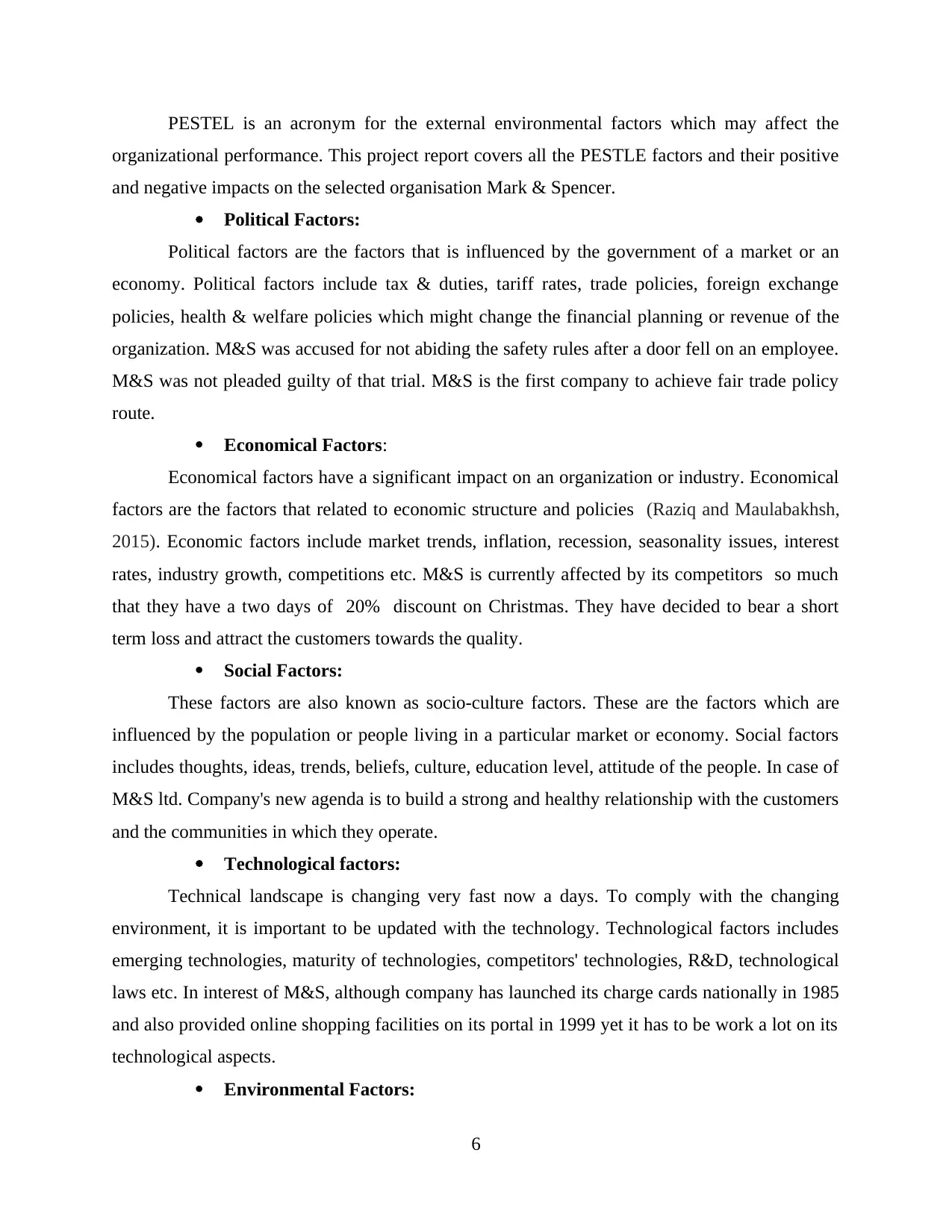
PESTEL is an acronym for the external environmental factors which may affect the
organizational performance. This project report covers all the PESTLE factors and their positive
and negative impacts on the selected organisation Mark & Spencer.
Political Factors:
Political factors are the factors that is influenced by the government of a market or an
economy. Political factors include tax & duties, tariff rates, trade policies, foreign exchange
policies, health & welfare policies which might change the financial planning or revenue of the
organization. M&S was accused for not abiding the safety rules after a door fell on an employee.
M&S was not pleaded guilty of that trial. M&S is the first company to achieve fair trade policy
route.
Economical Factors:
Economical factors have a significant impact on an organization or industry. Economical
factors are the factors that related to economic structure and policies (Raziq and Maulabakhsh,
2015). Economic factors include market trends, inflation, recession, seasonality issues, interest
rates, industry growth, competitions etc. M&S is currently affected by its competitors so much
that they have a two days of 20% discount on Christmas. They have decided to bear a short
term loss and attract the customers towards the quality.
Social Factors:
These factors are also known as socio-culture factors. These are the factors which are
influenced by the population or people living in a particular market or economy. Social factors
includes thoughts, ideas, trends, beliefs, culture, education level, attitude of the people. In case of
M&S ltd. Company's new agenda is to build a strong and healthy relationship with the customers
and the communities in which they operate.
Technological factors:
Technical landscape is changing very fast now a days. To comply with the changing
environment, it is important to be updated with the technology. Technological factors includes
emerging technologies, maturity of technologies, competitors' technologies, R&D, technological
laws etc. In interest of M&S, although company has launched its charge cards nationally in 1985
and also provided online shopping facilities on its portal in 1999 yet it has to be work a lot on its
technological aspects.
Environmental Factors:
6
organizational performance. This project report covers all the PESTLE factors and their positive
and negative impacts on the selected organisation Mark & Spencer.
Political Factors:
Political factors are the factors that is influenced by the government of a market or an
economy. Political factors include tax & duties, tariff rates, trade policies, foreign exchange
policies, health & welfare policies which might change the financial planning or revenue of the
organization. M&S was accused for not abiding the safety rules after a door fell on an employee.
M&S was not pleaded guilty of that trial. M&S is the first company to achieve fair trade policy
route.
Economical Factors:
Economical factors have a significant impact on an organization or industry. Economical
factors are the factors that related to economic structure and policies (Raziq and Maulabakhsh,
2015). Economic factors include market trends, inflation, recession, seasonality issues, interest
rates, industry growth, competitions etc. M&S is currently affected by its competitors so much
that they have a two days of 20% discount on Christmas. They have decided to bear a short
term loss and attract the customers towards the quality.
Social Factors:
These factors are also known as socio-culture factors. These are the factors which are
influenced by the population or people living in a particular market or economy. Social factors
includes thoughts, ideas, trends, beliefs, culture, education level, attitude of the people. In case of
M&S ltd. Company's new agenda is to build a strong and healthy relationship with the customers
and the communities in which they operate.
Technological factors:
Technical landscape is changing very fast now a days. To comply with the changing
environment, it is important to be updated with the technology. Technological factors includes
emerging technologies, maturity of technologies, competitors' technologies, R&D, technological
laws etc. In interest of M&S, although company has launched its charge cards nationally in 1985
and also provided online shopping facilities on its portal in 1999 yet it has to be work a lot on its
technological aspects.
Environmental Factors:
6

Environmental factors are related to the ecological and environmental aspects which
effect the production of the organization. It includes natural resources, ecological regulations,
carbon footprint, recycling policies, sustainability etc. M&S was involved in environment
friendly production of cotton and wool. Company charges 5p per plastic bag to decrease the use
of plastic.
Legal Factors:
Legal factors are related to rules, regulations, legislation and laws that affect the
organizational operations (Saleem, 2015). Consumer protection, employment laws, current and
future legislations, competitive regulations, health and safety regulations are some legal factors.
Marks & Spencer was found involvement in some illegal activities like slave labour, tax evading,
money laundering by observer but company refused all these claims.
TASK 4
P5. Internal and External Analysis of Specific organisations
SWOT analysis is a business strategy undertaken to conduct an internal as well as
external analysis of a company's business environment (Savrul, Incekara and Sener, 2014). It
calculates the facts and figures which help in the strategic planning and decision making of an
organisation. In the context of given case scenario, a SWOT analysis of Marks and Spencer has
been discussed as under:
Strengths:
M&S is chiefly focused on brand improvement and brand recognition with the value
prospective. It has a huge range of products and different outlets location which help in its
continuous growth and deliverance of excellent service to its customers. They have provided
superior quality to its customer over the years as a result its brand valuation is higher in
comparison to its competitors such as John Lewis and so on.
Weakness:
Even though Marks and Spencer has a huge range of products it has failed to achieve
right amount of publicity in relation to its different brands of clothing. That's the reason where
management has failed to attract young people to its stores. Before implementing mechanized
and automated technique for material handling with various types of logistic and cash operations,
M&S was not able to focus on the new technologies for the efficient work that falls to control the
7
effect the production of the organization. It includes natural resources, ecological regulations,
carbon footprint, recycling policies, sustainability etc. M&S was involved in environment
friendly production of cotton and wool. Company charges 5p per plastic bag to decrease the use
of plastic.
Legal Factors:
Legal factors are related to rules, regulations, legislation and laws that affect the
organizational operations (Saleem, 2015). Consumer protection, employment laws, current and
future legislations, competitive regulations, health and safety regulations are some legal factors.
Marks & Spencer was found involvement in some illegal activities like slave labour, tax evading,
money laundering by observer but company refused all these claims.
TASK 4
P5. Internal and External Analysis of Specific organisations
SWOT analysis is a business strategy undertaken to conduct an internal as well as
external analysis of a company's business environment (Savrul, Incekara and Sener, 2014). It
calculates the facts and figures which help in the strategic planning and decision making of an
organisation. In the context of given case scenario, a SWOT analysis of Marks and Spencer has
been discussed as under:
Strengths:
M&S is chiefly focused on brand improvement and brand recognition with the value
prospective. It has a huge range of products and different outlets location which help in its
continuous growth and deliverance of excellent service to its customers. They have provided
superior quality to its customer over the years as a result its brand valuation is higher in
comparison to its competitors such as John Lewis and so on.
Weakness:
Even though Marks and Spencer has a huge range of products it has failed to achieve
right amount of publicity in relation to its different brands of clothing. That's the reason where
management has failed to attract young people to its stores. Before implementing mechanized
and automated technique for material handling with various types of logistic and cash operations,
M&S was not able to focus on the new technologies for the efficient work that falls to control the
7
⊘ This is a preview!⊘
Do you want full access?
Subscribe today to unlock all pages.

Trusted by 1+ million students worldwide
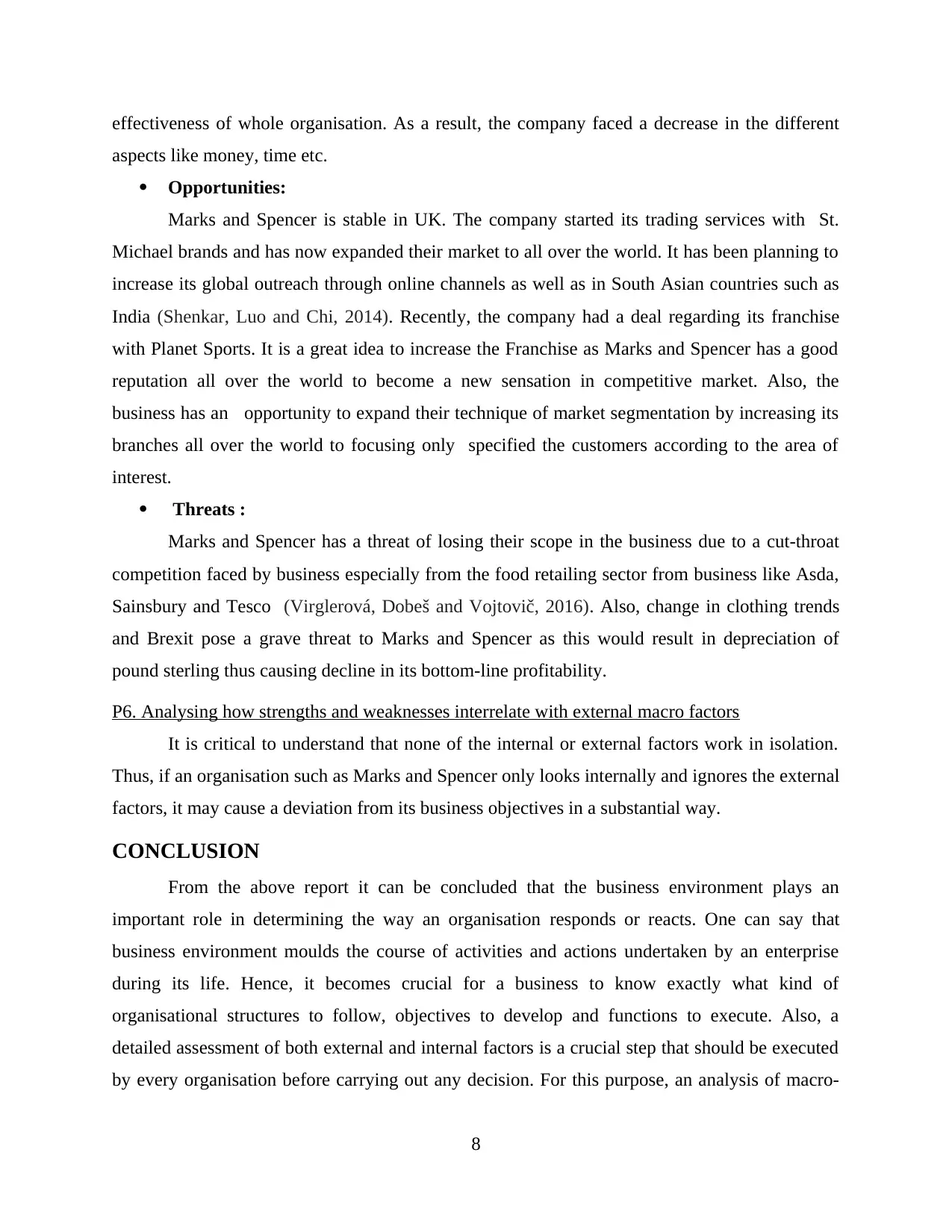
effectiveness of whole organisation. As a result, the company faced a decrease in the different
aspects like money, time etc.
Opportunities:
Marks and Spencer is stable in UK. The company started its trading services with St.
Michael brands and has now expanded their market to all over the world. It has been planning to
increase its global outreach through online channels as well as in South Asian countries such as
India (Shenkar, Luo and Chi, 2014). Recently, the company had a deal regarding its franchise
with Planet Sports. It is a great idea to increase the Franchise as Marks and Spencer has a good
reputation all over the world to become a new sensation in competitive market. Also, the
business has an opportunity to expand their technique of market segmentation by increasing its
branches all over the world to focusing only specified the customers according to the area of
interest.
Threats :
Marks and Spencer has a threat of losing their scope in the business due to a cut-throat
competition faced by business especially from the food retailing sector from business like Asda,
Sainsbury and Tesco (Virglerová, Dobeš and Vojtovič, 2016). Also, change in clothing trends
and Brexit pose a grave threat to Marks and Spencer as this would result in depreciation of
pound sterling thus causing decline in its bottom-line profitability.
P6. Analysing how strengths and weaknesses interrelate with external macro factors
It is critical to understand that none of the internal or external factors work in isolation.
Thus, if an organisation such as Marks and Spencer only looks internally and ignores the external
factors, it may cause a deviation from its business objectives in a substantial way.
CONCLUSION
From the above report it can be concluded that the business environment plays an
important role in determining the way an organisation responds or reacts. One can say that
business environment moulds the course of activities and actions undertaken by an enterprise
during its life. Hence, it becomes crucial for a business to know exactly what kind of
organisational structures to follow, objectives to develop and functions to execute. Also, a
detailed assessment of both external and internal factors is a crucial step that should be executed
by every organisation before carrying out any decision. For this purpose, an analysis of macro-
8
aspects like money, time etc.
Opportunities:
Marks and Spencer is stable in UK. The company started its trading services with St.
Michael brands and has now expanded their market to all over the world. It has been planning to
increase its global outreach through online channels as well as in South Asian countries such as
India (Shenkar, Luo and Chi, 2014). Recently, the company had a deal regarding its franchise
with Planet Sports. It is a great idea to increase the Franchise as Marks and Spencer has a good
reputation all over the world to become a new sensation in competitive market. Also, the
business has an opportunity to expand their technique of market segmentation by increasing its
branches all over the world to focusing only specified the customers according to the area of
interest.
Threats :
Marks and Spencer has a threat of losing their scope in the business due to a cut-throat
competition faced by business especially from the food retailing sector from business like Asda,
Sainsbury and Tesco (Virglerová, Dobeš and Vojtovič, 2016). Also, change in clothing trends
and Brexit pose a grave threat to Marks and Spencer as this would result in depreciation of
pound sterling thus causing decline in its bottom-line profitability.
P6. Analysing how strengths and weaknesses interrelate with external macro factors
It is critical to understand that none of the internal or external factors work in isolation.
Thus, if an organisation such as Marks and Spencer only looks internally and ignores the external
factors, it may cause a deviation from its business objectives in a substantial way.
CONCLUSION
From the above report it can be concluded that the business environment plays an
important role in determining the way an organisation responds or reacts. One can say that
business environment moulds the course of activities and actions undertaken by an enterprise
during its life. Hence, it becomes crucial for a business to know exactly what kind of
organisational structures to follow, objectives to develop and functions to execute. Also, a
detailed assessment of both external and internal factors is a crucial step that should be executed
by every organisation before carrying out any decision. For this purpose, an analysis of macro-
8
Paraphrase This Document
Need a fresh take? Get an instant paraphrase of this document with our AI Paraphraser

environmental factors and internal capabilities using PESTLE as well as SWOT techniques can
help in generation of effective strategies and enable impactful goal-setting for a given enterprise.
9
help in generation of effective strategies and enable impactful goal-setting for a given enterprise.
9
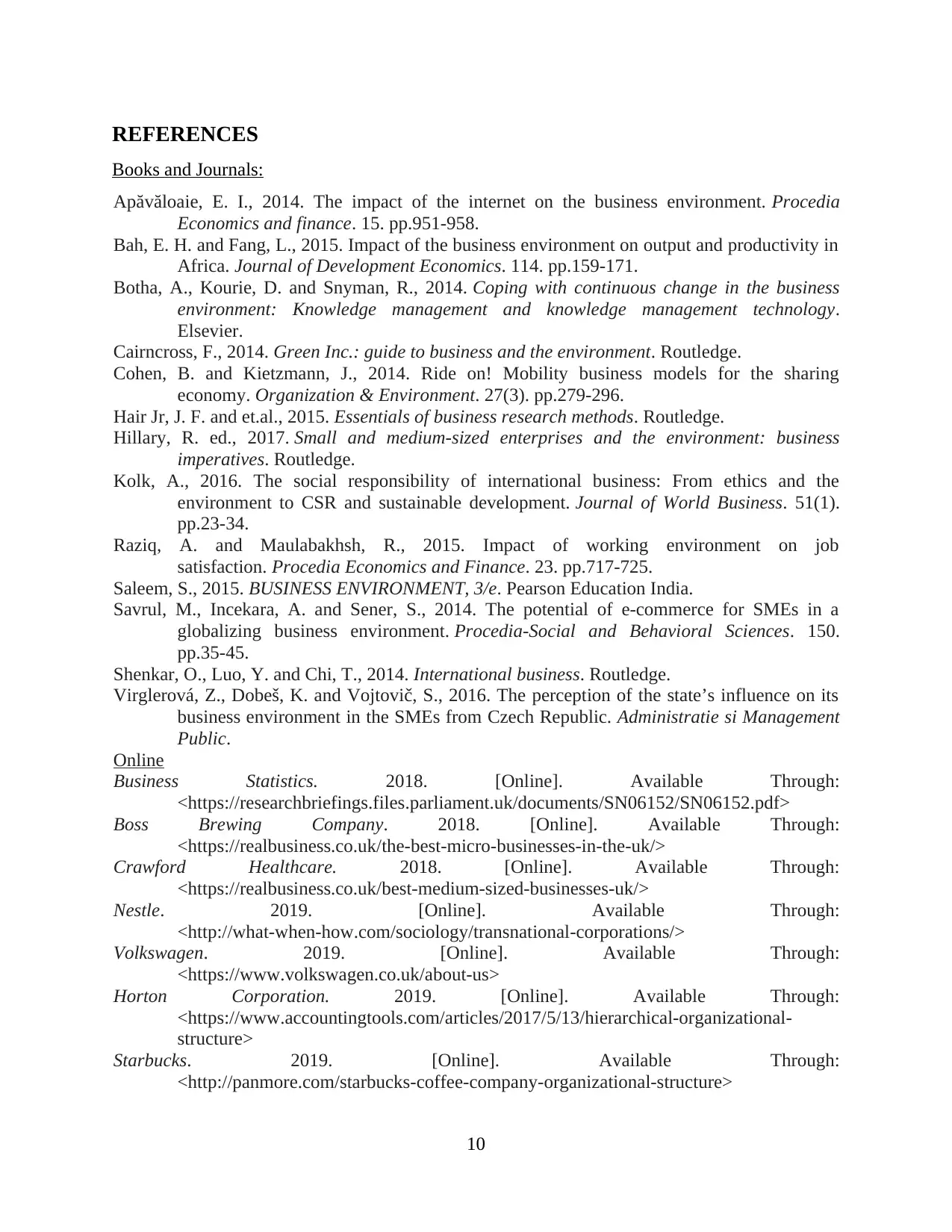
REFERENCES
Books and Journals:
Apăvăloaie, E. I., 2014. The impact of the internet on the business environment. Procedia
Economics and finance. 15. pp.951-958.
Bah, E. H. and Fang, L., 2015. Impact of the business environment on output and productivity in
Africa. Journal of Development Economics. 114. pp.159-171.
Botha, A., Kourie, D. and Snyman, R., 2014. Coping with continuous change in the business
environment: Knowledge management and knowledge management technology.
Elsevier.
Cairncross, F., 2014. Green Inc.: guide to business and the environment. Routledge.
Cohen, B. and Kietzmann, J., 2014. Ride on! Mobility business models for the sharing
economy. Organization & Environment. 27(3). pp.279-296.
Hair Jr, J. F. and et.al., 2015. Essentials of business research methods. Routledge.
Hillary, R. ed., 2017. Small and medium-sized enterprises and the environment: business
imperatives. Routledge.
Kolk, A., 2016. The social responsibility of international business: From ethics and the
environment to CSR and sustainable development. Journal of World Business. 51(1).
pp.23-34.
Raziq, A. and Maulabakhsh, R., 2015. Impact of working environment on job
satisfaction. Procedia Economics and Finance. 23. pp.717-725.
Saleem, S., 2015. BUSINESS ENVIRONMENT, 3/e. Pearson Education India.
Savrul, M., Incekara, A. and Sener, S., 2014. The potential of e-commerce for SMEs in a
globalizing business environment. Procedia-Social and Behavioral Sciences. 150.
pp.35-45.
Shenkar, O., Luo, Y. and Chi, T., 2014. International business. Routledge.
Virglerová, Z., Dobeš, K. and Vojtovič, S., 2016. The perception of the state’s influence on its
business environment in the SMEs from Czech Republic. Administratie si Management
Public.
Online
Business Statistics. 2018. [Online]. Available Through:
<https://researchbriefings.files.parliament.uk/documents/SN06152/SN06152.pdf>
Boss Brewing Company. 2018. [Online]. Available Through:
<https://realbusiness.co.uk/the-best-micro-businesses-in-the-uk/>
Crawford Healthcare. 2018. [Online]. Available Through:
<https://realbusiness.co.uk/best-medium-sized-businesses-uk/>
Nestle. 2019. [Online]. Available Through:
<http://what-when-how.com/sociology/transnational-corporations/>
Volkswagen. 2019. [Online]. Available Through:
<https://www.volkswagen.co.uk/about-us>
Horton Corporation. 2019. [Online]. Available Through:
<https://www.accountingtools.com/articles/2017/5/13/hierarchical-organizational-
structure>
Starbucks. 2019. [Online]. Available Through:
<http://panmore.com/starbucks-coffee-company-organizational-structure>
10
Books and Journals:
Apăvăloaie, E. I., 2014. The impact of the internet on the business environment. Procedia
Economics and finance. 15. pp.951-958.
Bah, E. H. and Fang, L., 2015. Impact of the business environment on output and productivity in
Africa. Journal of Development Economics. 114. pp.159-171.
Botha, A., Kourie, D. and Snyman, R., 2014. Coping with continuous change in the business
environment: Knowledge management and knowledge management technology.
Elsevier.
Cairncross, F., 2014. Green Inc.: guide to business and the environment. Routledge.
Cohen, B. and Kietzmann, J., 2014. Ride on! Mobility business models for the sharing
economy. Organization & Environment. 27(3). pp.279-296.
Hair Jr, J. F. and et.al., 2015. Essentials of business research methods. Routledge.
Hillary, R. ed., 2017. Small and medium-sized enterprises and the environment: business
imperatives. Routledge.
Kolk, A., 2016. The social responsibility of international business: From ethics and the
environment to CSR and sustainable development. Journal of World Business. 51(1).
pp.23-34.
Raziq, A. and Maulabakhsh, R., 2015. Impact of working environment on job
satisfaction. Procedia Economics and Finance. 23. pp.717-725.
Saleem, S., 2015. BUSINESS ENVIRONMENT, 3/e. Pearson Education India.
Savrul, M., Incekara, A. and Sener, S., 2014. The potential of e-commerce for SMEs in a
globalizing business environment. Procedia-Social and Behavioral Sciences. 150.
pp.35-45.
Shenkar, O., Luo, Y. and Chi, T., 2014. International business. Routledge.
Virglerová, Z., Dobeš, K. and Vojtovič, S., 2016. The perception of the state’s influence on its
business environment in the SMEs from Czech Republic. Administratie si Management
Public.
Online
Business Statistics. 2018. [Online]. Available Through:
<https://researchbriefings.files.parliament.uk/documents/SN06152/SN06152.pdf>
Boss Brewing Company. 2018. [Online]. Available Through:
<https://realbusiness.co.uk/the-best-micro-businesses-in-the-uk/>
Crawford Healthcare. 2018. [Online]. Available Through:
<https://realbusiness.co.uk/best-medium-sized-businesses-uk/>
Nestle. 2019. [Online]. Available Through:
<http://what-when-how.com/sociology/transnational-corporations/>
Volkswagen. 2019. [Online]. Available Through:
<https://www.volkswagen.co.uk/about-us>
Horton Corporation. 2019. [Online]. Available Through:
<https://www.accountingtools.com/articles/2017/5/13/hierarchical-organizational-
structure>
Starbucks. 2019. [Online]. Available Through:
<http://panmore.com/starbucks-coffee-company-organizational-structure>
10
⊘ This is a preview!⊘
Do you want full access?
Subscribe today to unlock all pages.

Trusted by 1+ million students worldwide
1 out of 13
Related Documents
Your All-in-One AI-Powered Toolkit for Academic Success.
+13062052269
info@desklib.com
Available 24*7 on WhatsApp / Email
![[object Object]](/_next/static/media/star-bottom.7253800d.svg)
Unlock your academic potential
Copyright © 2020–2026 A2Z Services. All Rights Reserved. Developed and managed by ZUCOL.





